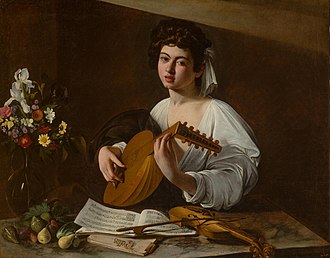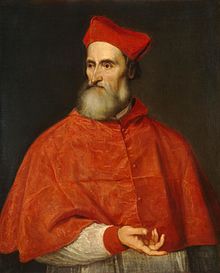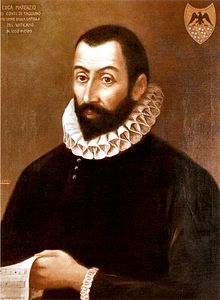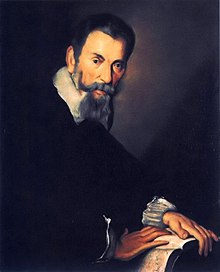Madrigal

| Part ofa serieson |
| Renaissance music |
|---|
| Overview |
|
|
|
|
Amadrigalis a form ofsecularvocal musicmost typical of theRenaissance(15th–16th centuries) and earlyBaroque(1600–1750)[citation needed]periods, although revisited by some later European composers.[1]Thepolyphonicmadrigal isunaccompanied,and the number of voices varies from two to eight, but the form usually features three to six voices, whilst themetreof the madrigal varies between two or threetercets,followed by one or twocouplets.[2]Unlike verse-repeatingstrophic formssung to the same music,[3]most madrigals arethrough-composed,featuring different music for each stanza of lyrics, whereby the composer expresses the emotions contained in each line and in single words of thepoembeing sung.[4]
Madrigals written by Italianized Franco–Flemish composers in the1520spartly originated from the three-to-four voicefrottola(1470–1530); partly from composers' renewed interest in poetry written invernacular Italian;partly from the stylistic influence of the Frenchchanson;and from the polyphony of themotet(13th–16th centuries). The technical contrast between the musical forms is in the frottola consisting of music set to stanzas of text, whilst the madrigal is through-composed, a work with different music for different stanzas.[5]As a composition, the madrigal of the Renaissance is unlike the two-to-three voiceItalian Trecento madrigal(1300–1370) of the 14th century, having in common only the namemadrigal,[6]which derives from the Latinmatricalis(maternal) denoting musical work in service to the mother church[2][need quotation to verify]or from the post-classical Latinmatricalis(maternal, simple, primitive).[7]
Artistically, the madrigal was the most important form of secular music inRenaissance Italy,and reached its formal and historical zenith in the later-16th century, when the form also was taken up by German and English composers, such asJohn Wilbye(1574–1638),Thomas Weelkes(1576–1623), andThomas Morley(1557–1602) of theEnglish Madrigal School(1588–1627). Although of British temper, most English madrigals werea cappellacompositions for three to six voices, which either copied or translated the musical styles of the original madrigals from Italy.[2]By the mid-16th century, Italian composers began merging the madrigal into the composition of thecantataand thedialogue;and by the early 17th century, theariareplaced the madrigal inopera.[6]
History
[edit]Origins and early madrigals
[edit]
The madrigal is a musical composition that emerged from the convergence ofhumanisttrends in 16th-century Italy. First, renewed interest in the use of Italian as thevernacular languagefor daily life and communication, instead of Latin. In 1501, the literary theoristPietro Bembo(1470–1547) published an edition of the poetPetrarch(1304–1374); and published theOratio pro litteris graecis(1453) about achieving graceful writing by applyingLatin prosody,careful attention to the sounding of words, andsyntax,the positioning of a word within a line of text. As a form of poetry, the madrigal consisted of an irregular number of lines (usually 7–11 syllables) without repetition.[6][8][9]
Second, Italy was the usual destination for theoltremontani( "those from beyond the Alps" ) composers of theFranco-Flemish school,who were attracted byItalian cultureand by employment in the court of an aristocrat or with the Roman Catholic Church. The composers of the Franco-Flemish school had mastered the style ofpolyphoniccomposition for religious music, and knew the secular compositions of their homelands, such as thechanson,which much differed from the secular, lighter styles of composition in late-15th- and early-16th-century Italy.[6]
Third, the printing press facilitated the availability of sheet music in Italy. The musical forms then in common use — thefrottolaand theballata,thecanzonettaand themascherata— were light compositions with verses of low literary quality. Those musical forms used repetition and soprano-dominatedhomophony,chordal textures and styles, which were simpler than the composition styles of the Franco-Flemish school. Moreover, the Italian popular taste in literature was changing from frivolous verse to the type of serious verse used by Bembo and his school, who required more compositional flexibility than that of the frottola, and related musical forms.[6][9]
The madrigal slowly replaced the frottola in the transitional decade of the 1520s. The early madrigals were published inMusica di messer Bernardo Pisano sopra le canzone del Petrarcha(1520), byBernardo Pisano(1490–1548), while no one composition is namedmadrigal,some of the settings are Petrarchan inversificationandword-painting,which became compositional characteristics of the later madrigal.[6]TheMadrigali de diversi musici: libro primo de la Serena(1530), byPhilippe Verdelot(1480–1540), included music bySebastiano Festa(1490–1524) andCostanzo Festa(1485–1545),Maistre Jhan(1485–1538) and Verdelot, himself.[6]
In the 1533–34 period, at Venice, Verdelot published two popular books of four-voice madrigals that were reprinted in 1540. In 1536, that publishing success prompted the founder of theFranco-Flemish school,Adrian Willaert(1490–1562), to rearrange some four-voice madrigals for single-voice and lute. In 1541, Verdelot also published five-voice madrigals and six-voice madrigals.[6]The success of the first book of madrigals,Il primo libro di madrigali(1539), byJacques Arcadelt(1507–1568), made it the most reprinted madrigal book of its time.[10]Stylistically, the music in the books of Arcadelt and Verdelot was closer to the French chanson than the Italian frottola and themotet,given that French was their native tongue. As composers, they were attentive to the setting of the text, per Bembo's ideas, and through-composed the music, rather than use the refrain-and-verse constructions common to French secular music.[11]
Mid-16th century
[edit]Although the madrigal originated in the cities of Florence and Rome, by the mid 16th-century Venice had become the centre of musical activity. The political turmoils of theSack of Rome (1527)and theSiege of Florence (1529–1530)diminished that city's significance as a musical centre. In addition, Venice was the music publishing centre of Europe; the Basilica ofSan Marco di Venezia(St. Mark's Basilica) was beginning to attract musicians from Europe; and Pietro Bembo had returned to Venice in 1529.Adrian Willaert(1490–1562) and his associates at St. Mark's Basilica,Girolamo Parabosco(1524–1557),Jacques Buus(1524–1557), andBaldassare Donato(1525–1603),Perissone Cambio(1520–1562) andCipriano de Rore(1515–1565), were the principal composers of the madrigal at mid-century.
Unlike Arcadelt and Verdelot, Willaert preferred the complex textures of polyphonic language, thus his madrigals were like motets, although he varied the compositional textures, between homophonic and polyphonic passages, to highlight the text of the stanzas; for verse, Willaert preferred thesonnetsof Petrarch.[6][12][13]Second to Willaert, Cipriano de Rore was the most influential composer of madrigals; whereas Willaert was restrained and subtle in his settings for the text, striving for homogeneity, rather than sharp contrast, Rore used extravagant rhetorical gestures, including word-painting and unusualchromaticrelationships, a compositional trend encouraged by the music theoristNicola Vicentino(1511–1576).[10][14]From Rore's musical language came themadrigalismsthat made the genre distinctive, and the five-voice texture which became the standard for composition.[15]
1550s–1570s
[edit]

The latter history of the madrigal begins with Cipriano de Rore, whose works were the elementary musical forms of madrigal composition that existed by the early 17th century.[6][16]The relevant composers includeGiovanni Pierluigi da Palestrina(1525–1594), who wrote secular music in his early career;Orlande de Lassus(1530–1594), who wrote the twelve-motetProphetiae Sibyllarum(Sibylline Prophecies, 1600), and later, when he moved to Munich in 1556, began the history of madrigal composition beyond Italy; andPhilippe de Monte(1521–1603), the most prolific madrigalist, first published in 1554.[6][17]
In Venice,Andrea Gabrieli(1532–1585) composed madrigals with bright, open, polyphonic textures, as in hismotetcompositions. At the court ofAlfonso II d'Este, Duke of Ferrara(r. 1559–1597), there was theConcerto delle donne(1580–1597), the concert of the ladies, three women singers for whomLuzzasco Luzzaschi(1545–1607),Giaches de Wert(1535–1596), andLodovico Agostini(1534–1590) composed ornamented madrigals, often with instrumental accompaniment. The great artistic quality of theConcerto delle donneof Ferrara encouraged composers to visit the court at Ferrara, to listen to women sing and to offer compositions for them to sing. In turn, other cities established their ownconcerto delle donne,as at Firenze, where theMedicifamily commissionedAlessandro Striggio(1536–1592) to compose madrigals in the style of Luzzaschi.[6]In Rome, the compositions ofLuca Marenzio(1553–1599) were the madrigals that came closest to unifying the different styles of the time.[18]
In the 1560s,Marc'Antonio Ingegneri(1535–1592) — Monteverdi's instructor —Andrea Gabrieli(1532–1585), andGiovanni Ferretti(1540–1609) re-incorporated lighter elements of composition to the madrigal; serious Petrarchan verse aboutLove,Longing,andDeathwas replaced with thevillanellaand thecanzonetta,compositions with dance rhythms and verses about a care-free life.[10]In the late 16th century, composers usedword-paintingto applymadrigalisms,passages in which the music matches the meaning of a word in the lyrics; thus, a composer setsriso(smile) to a passage of quick, running notes that mimic laughter, and setssospiro(sigh) to a note that falls to the note below. In the 17th century, acceptance of word-painting as a musical form had changed, in theFirst Book of Ayres(1601), the poet and composerThomas Campion(1567–1620) criticised word-painting as a negative mannerism in the madrigal: "where the nature of everie word is precisely expresst in the Note... such childish observing of words is altogether ridiculous."[19]
Turn of the century
[edit]
At the end of the 16th century, the changed social function of the madrigal contributed to its development into new forms of music. Since its invention, the madrigal had two roles: (i) a private entertainment for small groups of skilled, amateur singers and musicians; and (ii) a supplement to ceremonial performances of music for the public. The amateur entertainment function made the madrigal famous, yet professional singers replaced amateur singers when madrigalists composed music of greater range and dramatic force that was more difficult to sing, because the expressed sentiments required soloist singers of great range, rather than an ensemble of singers with mid-range voices.
There emerged the division between the active performers and the passive audience, especially in the culturally progressive cities ofFerraraandMantua.The emotions communicated in a madrigal in 1590, anariaexpressed inoperaat the beginning of the 17th century, yet composers continued using the madrigal into the new century, such as the old-style madrigal for many voices; the solo madrigal with instrumental accompaniment; and theconcertatomadrigal, of whichClaudio Monteverdi(1567–1643) was the most famous composer.[6]
In Naples, the compositional style of the pupil Carlo Gesualdo followed from the style of his mentor,Luzzasco Luzzaschi(1545–1607), who had published six books of madrigals and the religious musicResponsoria pro hebdomada sancta(Responsories for Holy Week,1611). In the early 1590s, Gesualdo had learnt thechromaticismand textural contrasts of Ferrarese composers, such asAlfonso Fontanelli(1557–1622) and Luzzaschi, but few madrigalists followed his stylisticmannerismand extreme chromaticism, which were compositional techniques selectively used byAntonio Cifra(1584–1629),Sigismondo d'India(1582–1629), andDomenico Mazzocchi(1592–1665) in their musical works.[6][20][21]In the 1620s, Gesualdo's successor madrigalist wasMichelangelo Rossi(1601–1656), whose two books of unaccompanied madrigals display sustained, extreme chromaticism.[22]
Transition to the concertato madrigal
[edit]
In the transition fromRenaissance music(1400–1600) toBaroque music(1580–1750),Claudio Monteverdiusually is credited as the principal madrigalist whose nine books of madrigals showed the stylistic, technical transitions from thepolyphonyof the late 16th century to the styles ofmonodyand of theconcertatoaccompanied bybasso continuo,of the early Baroque period. As an expressive composer, Monteverdi avoided the stylistic extremes of Gesualdo's chromaticism, and concentrated upon the drama inherent to the madrigal musical form. His fifth and sixth books include polyphonic madrigals for equal voices (in late-16th-century style) and madrigals with solo-voice parts accompanied by basso continuo, which feature unprepared dissonances andrecitativepassages — foreshadowing the compositional integration of the solo madrigal to thearia.In the fifth book of madrigals, using the termseconda pratica(second practice) Monteverdi said that the lyrics must be "the mistress of the harmony" of a madrigal, which was his progressive response toGiovanni Artusi(1540–1613) who negatively defended the limitations of dissonance and equal voice parts of the old-style polyphonic madrigal against the concertato madrigal.[23][24]
Transition from the concertato madrigal
[edit]In the first decade of the 17th century, the Italian compositional techniques for the madrigal progressed from the old ideal of ana cappellavocal composition for balanced voices, to a vocal composition for one or more voices with instrumental accompaniment. The inner voices became secondary to thesopranoand thebass line;functional tonality developed, and treated dissonance freely for composers to emphasise the dramatic contrast among vocal groups and instruments. The 17th-century madrigal emerged from two trends of musical composition: (i) the solo madrigal with basso continuo; and (ii) the madrigal for two or more voices with basso continuo. In England, composers continued to write ensemble madrigals in the older, 16th-century style.[23][6]In 1600, the harmonic and dramatic changes in the composition of the madrigal expanded to include instrumental accompaniment, because the madrigal originally was composed for group performance by talented, amateur artists, without a passive audience; thus instruments filled the missing parts. The composer usually did not specify the instrumentation; inThe Fifth Book of Madrigalsand in theSixth Book of Madrigals,Claudio Monteverdiindicated that thebasso seguente,the instrumental bass part, was optional in the ensemble madrigal. The usual instruments for playing the bass line and filling inner voice parts, were thelute,thetheorbo(chitarrone), and theharpsichord.[23][6]

The madrigalistGiulio Caccini(1551–1618) produced madrigals in thesolo continuostyle, compositions technically related tomonodyand descended from the experimental music of theFlorentine Camerata(1573–1587). In the collection of solo madrigals,Le nuove musiche(The New Music,1601), Caccini said that the point of the composition was anti-contrapuntal, because the lyrics and words of the song were primary, and balanced-voice polyphony interfered with hearing the lyrics of the song. After Caccini's developments, the composersMarco da Gagliano(1582–1643),Sigismondo d'India(1582–1629), andClaudio Saracini(1586–1630) also published collections of madrigals in the solo continuo style. Whereas Caccini's music mostly wasdiatonic,later composers, especially d'India, composed solo continuo madrigals using an experimental idiom ofchromaticism.In theSeventh Book of Madrigals(1619), Monteverdi published his only madrigal in the solo continuo style, which uses one singing voice, and three groups of instruments — a great technical advance from Caccini's simple voice-and-basso-continuo compositions from the 1600 period.[6]
Beginning around 1620, theariasupplanted the monodic-style madrigal. In 1618, the last, published book of solo madrigals contained no arias, likewise in that year, books of arias contained no madrigals, thus published arias outnumbered madrigals, and the prolific madrigalists Saracini and d'India ceased publishing in the mid-1620s.[6]
In the late 1630s, two madrigal collections summarised the compositional and technical practises of the late-style madrigal. InMadrigali a 5 voci in partitura(1638),Domenico Mazzocchicollected and organised madrigals intocontinuoand ensemble works specifically composed fora cappellaperformance. For the first time in a collection of madrigal music, Mazzocchi published precise instructions, including the symbols forcrescendoanddecrescendo;however, those madrigals were formusicologic study,not for performance, indicating composer Mazzochi's retrospective review of the madrigal as an old form of musical composition.[25]In theEighth Book of Madrigals(1638), Monteverdi published his most famous madrigal, theCombattimento di Tancredi e Clorinda,a dramatic composition much like a secularoratorio,featuring musical innovations such as thestile concitato(agitated style) that employs the stringtremolo.In the event, the evolution of musical composition eliminated the madrigal as a discrete musical form; thesolo cantataand the aria supplanted the solo continuo madrigal, and the ensemble madrigal was supplanted by the cantata and the dialogue, and, by 1640, the opera was the predominant dramatic musical form of the 17th century.[23]
English madrigal school
[edit]In 16th-century England, the madrigal became greatly popular upon publication ofMusica Transalpinain (Transalpine Music,1588), byNicholas Yonge(1560–1619) a collection of Italian madrigals with corresponding English translations of the lyrics, which later initiated madrigal composition in England. The unaccompanied madrigal survived longer in England than in Continental Europe, where the madrigal musical form had fallen from popular favour, but English madrigalists continued composing and producing music in the Italian style of the late-16th century.

In early 18th-century England, the singing of madrigals was revived bycatch clubsandglee clubs,leading to an upsurge of interest in the form[26][27]and creation of musical institutions such as theMadrigal Society,which was established in London by attorney and amateur musicianJohn Immynsin 1741.[28]In the 19th century, the madrigal was the best-known music from theRenaissance(15th–16th c.) consequent to the prolific publishing of sheet music in the 16th and 17th centuries, even before the rediscovery of the madrigals of the composerPalestrina(Giovanni Pierluigi da Palestrina).[6]
Continental Europe
[edit]In the 16th century, the musical form of the Italian madrigal greatly influenced secular music throughout Europe, which composers wrote either in Italian or in their native tongues. The extent of madrigalist musical influence depended upon the cultural strength of the local tradition of secular music. In France, the native composition of thechansondisallowed the development of a French-style madrigal; nonetheless, French composers such asOrlande de Lassus(1532–1594) andClaude Le Jeune(1528–1600) applied madrigalian techniques in their musics.[6]In the Netherlands,Cornelis Verdonck(1563–1625),Hubert Waelrant(1517–1595), andJan Pieterszoon Sweelinck(1562–1621) composed madrigals in Italian.[6]
In German-speaking Europe, the prolific composers of madrigals included Lassus in Munich andPhilippe de Monte(1521–1603) in Vienna. The German-speaking composers who studied the Italian techniques for composing madrigals, especially in Venice, includedHans Leo Hassler(1564–1612) who studied withAndrea Gabrieli,andHeinrich Schütz(1585–1672) who studied withGiovanni Gabrieli.From northern Europe, Danish and Polish court composers went to Italy to learn the Italian style of madrigal; whileLuca Marenzio(1553–1599) went to the Polish court to work as themaestro di cappella(Master of the chapel) for KingSigismund III Vasa(r. 1587–1632) in Warsaw.[6]Moreover, therektorof the University of Wittenberg,Caspar Ziegler(1621–1690) and Heinrich Schütz wrote the treatiseVon den Madrigalen(1653).[29]
Madrigalists
[edit]Trecento madrigal
[edit]Early composers
[edit]- Jacques Arcadelt– I Libro a 4, 1543. Author of the most reprinted book of madrigals.
- Francesco Corteccia– court composer toCosimo I de Medici
- Costanzo Festa– I Libro a 3, 1541.
- Bernardo Pisano
- Cypriano de Rore- I Libro a 5, 1542
- Philippe Verdelot– I Libro a 5, 1535. One of the first madrigalists, also associated with the Medici court
- Adrian Willaert– Franco-Flemish composer, founder of theVenetian School
Late Renaissance composers
[edit]- Andrea Gabrieli– I Libro a 3, 1575
- Orlando di Lasso
- Francisco Leontaritis
- Philippe de Monte– author of the largest number of madrigal books.
- Giovanni Pierluigi da Palestrina– famous mostly for his sacred music, he also wrote at least 140 secular madrigals.
- Giovan Leonardo Primavera
At the Baroque threshold
[edit]- Camillo Cortellini– I Libro a 5 e 6, 1583
- Carlo Gesualdo– I Libro, 1594
- Sigismondo d'India– I Libro a 5, 1606
- Luzzasco Luzzaschi– I Libro a 5, 1571
- Luca Marenzio– I Libro a 5, 1580
- Claudio Monteverdi– I Libro a 5, 1587
- Giaches de Wert– I Libro a 5, 1558
Baroque madrigalists
[edit]Thea capellaold-style madrigal for four or five voices continued in parallel with the newconcertatostyle of madrigal, but the compositional watershed of theseconda pratticaprovided an autonomous basso continuo line, presented in theFifth Book of Madrigals(1605), by Claudio Monteverdi.
Italy
[edit]- Agostino Agazzari– I Libro a 5, 1600
- Adriano Banchieri
- Antonio Caldara
- Antonio Lotti
- Giulio Caccini
- Antonio Cifra– I Libro a 5, 1605
- Sigismondo d'India
- Marco da Gagliano– I Libro a 5, 1602
- Alessandro Grandi
- Marco Marazzoli
- Domenico Mazzocchi– Madrigali a 5, 1638
- Claudio Monteverdi
- Giovanni Priuli– I Libro, 1604
- Paolo Quagliati– I Libro a 4, 1608
- Michelangelo Rossi
- Salamone Rossi– I Libro a 5, 1600. HisSecondo Libro,1602, is the first example of madrigals published with continuo.
- Claudio Saracini
- Barbara Strozzi– I Libro a 2-5vv with bc, 1644
- Orazio Vecchi– I Libro a 6, 1583
Germany
[edit]- Hans Leo Hassler– I Libro, 1600
- Johann Hermann Schein
- Heinrich Schütz– I Libro a 5, Venice 1611.
English madrigal school
[edit]- Thomas Bateson
- William Byrd
- John Dowland
- John Farmer
- Orlando Gibbons
- Thomas Morley
- Thomas Tomkins
- Thomas Weelkes
- John Wilbye
Some 60 madrigals of the English School are published inThe Oxford Book of English Madrigals
English composers of the classical period
[edit]19th-century composers
[edit]20th-century composers
[edit]Contemporary
[edit]- Gavin Bryars
- George Crumb
- Emma Lou Diemer
- Mauricio Kagel
- Morten Lauridsen
- György Ligeti
- Paul Mealor
- Moondog
- Henri Pousseur
- Ned Rorem
Musical examples
[edit]- Stage 1 Madrigal: Arcadelt,Ahime, dov'e bel viso,1538
- Stage 2 Madrigal (prima practica): Willaert,Aspro core e selvaggio,mid-1540s
- Stage 3 Madrigal (seconda practica): Gesualdo,Io parto e non piu dissi,1590–1611
- Stage 4 Madrigal: Caccini,Perfidissimo volto,1602
- Stage 5 Madrigal: Monteverdi,Il Combatimento di Tancredi et Clorinda,1624
- English Madrigal: Weelkes,O Care, thou wilt despatch me,late 16th century/early 17th century
- Nineteenth-century imitation of an English Madrigal: "Brightly dawns our wedding day" from theGilbert and Sullivancomicopera,The Mikado(1885)
References
[edit]Notes
[edit]- ^Hobson, James (2015).Musical antiquarianism and the madrigal revival in England, 1726-1851(Ph.D.).University of Bristol.Retrieved2 October2022– viaEThOS.
- ^abcJ. A. Cuddon, ed. (1991).The Penguin Dictionary of Literary Terms and Literary Theory.p. 521.
- ^Tilmouth, Michael (1980), "Strophic", inSadie, Stanley(ed.),The New Grove Dictionary of Music and Musicians,vol. 18, London: Macmillan Press, pp. 292–293,ISBN0-333-23111-2
- ^Scholes, Percy A.(1970). Ward, John Owen (ed.).The Oxford Companion to Music(Tenth ed.). Oxford: Oxford University Press. p. 308.ISBN0-19-311306-6.
Durchkomponiert (G.) Through-composed; applied to songs with different music for every stanza, i.e. not merely a repeated tune.
- ^Brown 1976,p. 198
- ^abcdefghijklmnopqrstuvvon Fischer & et al. 2001
- ^ "madrigal".Oxford English Dictionary(Online ed.).Oxford University Press.(Subscription orparticipating institution membershiprequired.)
- ^Atlas 1998,p. 433.
- ^abBrown 1976,p. 221
- ^abcRandel 1986,p. 463
- ^Atlas 1998,pp. 431–432.
- ^Atlas 1998,pp. 432ff.
- ^Brown 1976,pp. 221–224.
- ^Brown 1976,pp. 224–225.
- ^Einstein 1949,Vol. I, p. 391.
- ^Brown 1976,p. 228.
- ^Reese 1954,p. 406.
- ^Atlas 1998,pp. 636–638.
- ^Campion, Thomas.First Booke of Ayres(1601), quoted invon Fischer & et al. 2001
- ^Bianconi, Lorenzo; Watkins, Glenn (2001). Watkins, Glenn (ed.)."Gesualdo, Carlo, Prince of Venosa, Count of Conza".Grove Music Online.Oxford University Press.doi:10.1093/gmo/9781561592630.article.10994.ISBN9781561592630.
- ^Einstein 1949,Vol II, pp. 867–871.
- ^The Madrigals of Michelangelo Rossi,Brian Mann, Ed. University of Chicago Press, 2003.
- ^abcdArnold & Wakelin 2011
- ^Artusi 1950,p. 395.
- ^Bukofzer, Manfred R.(1947).Music in the Baroque Era: From Monteverdi to Bach.New York: W. W. Norton & Company. p. 37.OCLC318558558.Retrieved3 October2022.
- ^Lovell, Percy (1979)."'Ancient' Music in Eighteenth-Century England ".Music & Letters.60(4). Oxford University Press: 401–415.doi:10.1093/ml/60.4.401.JSTOR733505– via JSTOR.
- ^Day, Thomas (1972)."Old Music in England, 1790-1820".Revue Belge de Musicologie / Belgisch Tijdschrift voor Muziekwetenschap.26/27. Societe Belge de Musicologie: 25–37.doi:10.2307/3686537.JSTOR3686537– via JSTOR.
- ^Craufurd, J. G. (1956)."The Madrigal Society".Proceedings of the Royal Musical Association(82nd session).82.Taylor & Francis: 33–46.doi:10.1093/jrma/82.1.33.ISSN0080-4452.JSTOR765866– via JSTOR.
- ^Von den Madrigalen.Leipzig: Digitalisat. 1653.
Sources
[edit]- Arnold, Denis;Wakelin, Emma (2011)."Madrigal".In Alison Latham (ed.).The Oxford Companion to Music.ISBN978-0-19-957903-7.(subscription required)
- Artusi, Giovanni (1950). "Della imperfezioni della moderna musica".Source Readings in Music History.Translated by Oliver Strunk. New York: W. W. Norton.
- Atlas, Allan W. (1998).Renaissance Music: Music in Western Europe, 1400–1600.New York: W. W. Norton.ISBN0-393-97169-4.
- Brown, Howard Mayer (1976).Music in the Renaissance.Prentice Hall History of Music Series. Englewood Cliffs, New Jersey: Prentice-Hall.ISBN0-13-608497-4.
- Einstein, Alfred(1949).The Italian Madrigal(Three volumes). Princeton, New Jersey: Princeton University Press.ISBN0-691-09112-9.
- von Fischer, Kurt;D'Agostino, Gianluca;Haar, James;Newcomb, Anthony; Ossi, Massimo;Fortune, Nigel;Kerman, Joseph;Roche, Jerome (2001). "Madrigal". In L. Macy (ed.).Grove Music Online.doi:10.1093/gmo/9781561592630.article.40075.ISBN978-1-56159-263-0.(subscription required)
- Randel, Don,ed. (1986).The NewHarvard Dictionary of Music.Cambridge, Massachusetts: Harvard University Press.ISBN0-674-61525-5.
- Reese, Gustav(1954).Music in the Renaissance.New York: W. W. Norton.ISBN0-393-09530-4.
Further reading
[edit]- Iain Fenlon andJames Haar:The Italian Madrigal in the Early 16th Century: Sources and Interpretation.Cambridge, 1988
- Oliphant, Thomas,ed. (1837)La musa madrigalesca, or, A collection of madrigals, ballets, roundelays etc.: chiefly of the Elizabethan age;with remarks and annotations. London: Calkin and Budd
- Choral Public Domain Librarycontains scores for many madrigals
External links
[edit]- Gosse, Edmund William;Tovey, Donald Francis(1911)..Encyclopædia Britannica.Vol. 17 (11th ed.). p. 295.
- Early Music;free recordings of English Madrigals,free recordings of German Liederandfree recordings of Spanish Madrigals,fromUmeå Academic Choir,Academic Computer Club,Umeå University,Sweden
- The Italian Madrigal Resource Center
